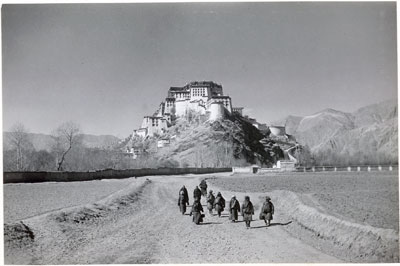
BMR.86.1.10.4 (Album Print black & white)


BMR.86.1.10.4 (Album Print black & white)

Frederick Spencer Chapman
Hugh E. Richardson
February 10th 1937?
Lhasa > Potala (from east)
BMR.86.1.10.4
Print gelatin silver
British Diplomatic Mission to Lhasa 1936-37
Donated to the British Museum in 1986 by Hugh E. Richardson
C.12 [view film roll]
F. S. Chapman Collection in the Pitt Rivers Museum
1998.131.297
Notes on print/mount - 'Potala from east' has been written beneath the image in the album in pencil, apparently not by Hugh Richardson [MS 10/06/2006]
Manual Catalogues - Caption in Chapman's hand-written list of negatives made whilst on the Mission to Lhasa, 1936-7 [See PRM Manuscripts Collection]: '1/2 Potala Horpas from the E.[ast]'; PRM Manuscripts Collection: ‘List of Tibetan Prints and Negatives’ - Book 2: ‘4/1 - Nomads from Chang Tang approaching Western end of Potala’ [MS 18/03/2006]
Research publication - Clare Harris and Tsering Shakya (eds) 'Seeing Lhasa: British Depictions of the Tibetan capital 1936-1947' Chicago: Serindia, 2003, facing page 1 [MS 10/06/2006]
Other Information - Album: This image appears alongside three other images of the Potala from various vantage points on page 10 of Hugh Richardson's album 'Lhasa 1936' [MS 10/06/2006]
Other Information - Related Images: Images prefixed with 'C' comprise a group of negatives containing images of the Potala and dancers at the Potala. They seem to have been taken on or around February 10th 1937, mainly related to the Tse Gutor ceremony on that day [MS 02/04/2006]
Other Information - Cultural Background: Chapman described in his book Lhasa the Holy City [London: Chatto & Windus, 1938; reprint, London: Readers Union Ltd., 1940] how in the weeks before the New Year festivities in February, it was common to see groups of nomads walking daily on the pilgrimage route around the Potala and Lhasa called the Lingkhor : "While they are in Lhasa, in fact this may be the primary object of their journey, they visit the shrine of the Dalai Lama and the Cathedral. The nomads, in the off season, are notorious brigands, making it unsafe for pilgrims or merchants to cross the Chang Tang except in large caravans, which are formed at regular times each year for mutual protection. They rarely rob their victims of money or valuables that are being taken as an offering to the Jo-kang or the Dalai Lama's tomb, for the nomads are notoriously pious, and sometimes they will save up for years and present surprisingly rich gifts to these shrines" [ibid., p.160] [MS 4/4/2005]
Other Information - Setting: The Potala Palace showing the Taktshang Gormo watch tower on its eastern side. A group of Tibetans (including monks) can be seen walking away from Lhasa. They may have completed the route of the Lingkhor (sacred walk) around the city in order to gain merit and the chance of a better rebirth. Lhasa was a site of pilgrimage for people from all over Tibet. Due to its height the Potala dominates the landscape of the Lhasa valley serving a visual as well as a spiritual focus for the city. Western visitors also succumbed to this awe inspiring sight [CH 2003]
For Citation use:
The Tibet Album.
"Potala from the east with nomads on path"
05 Dec. 2006. The British Museum.
<http://tibet.prm.ox.ac.uk/photo_BMR.86.1.10.4.html>.
For more information about photographic usage or to order prints, please visit the The British Museum.
© The British Museum